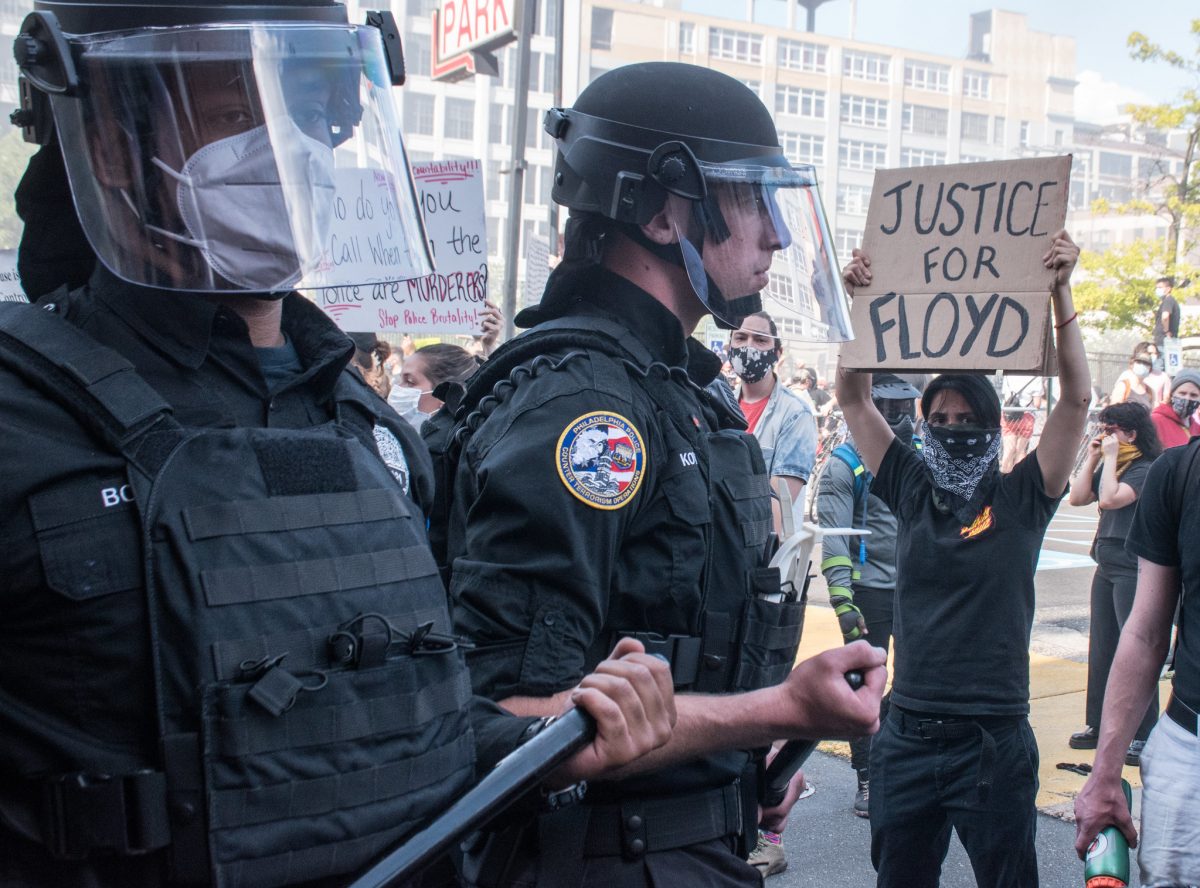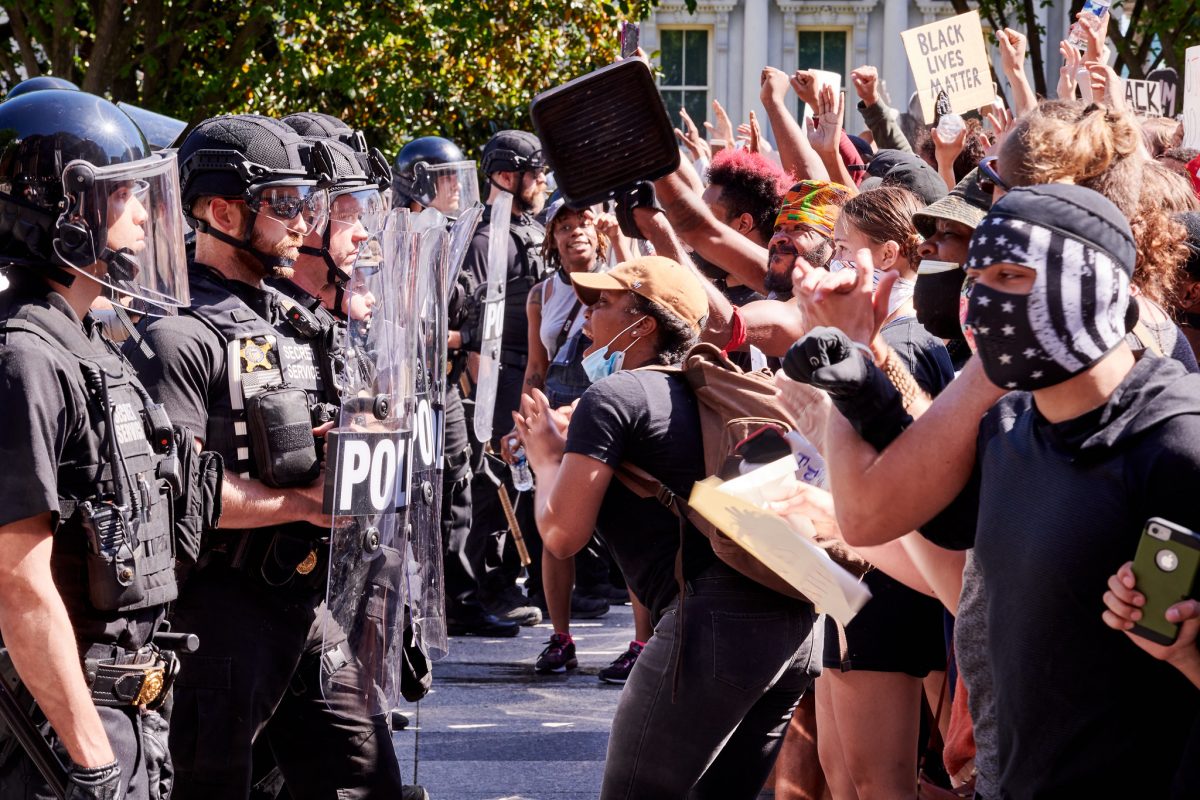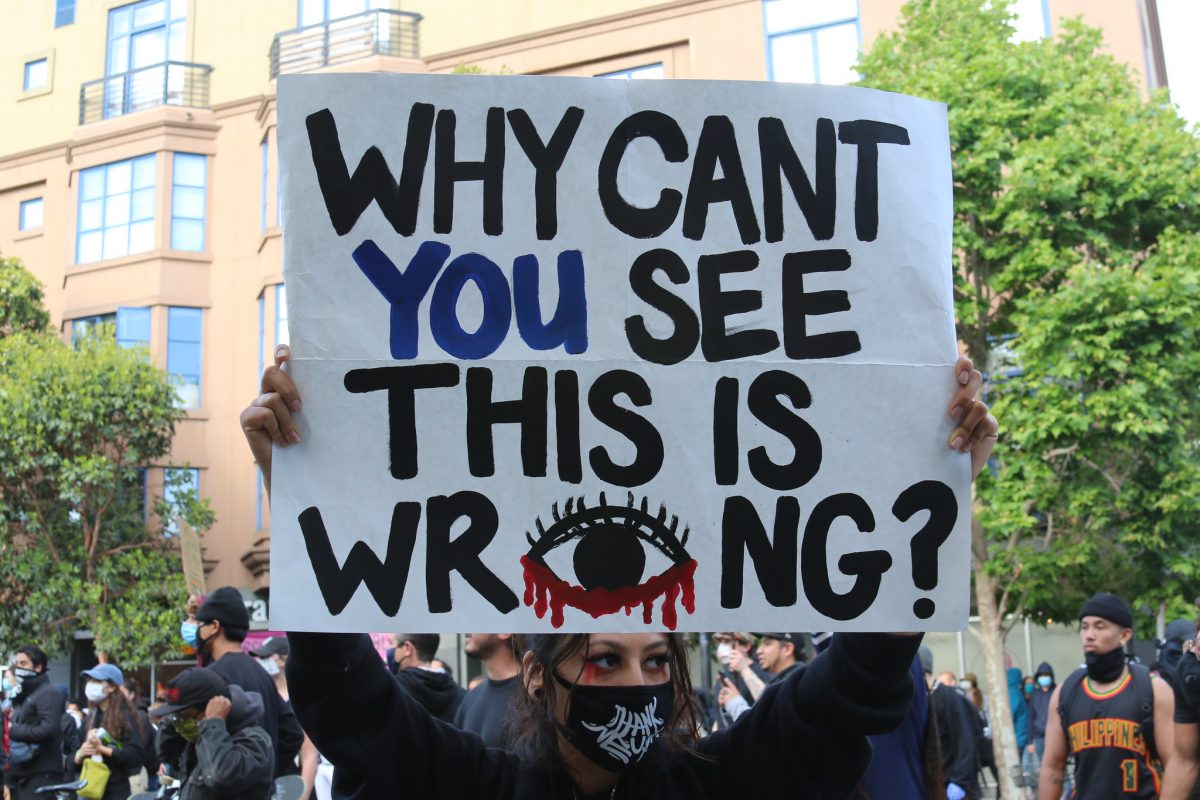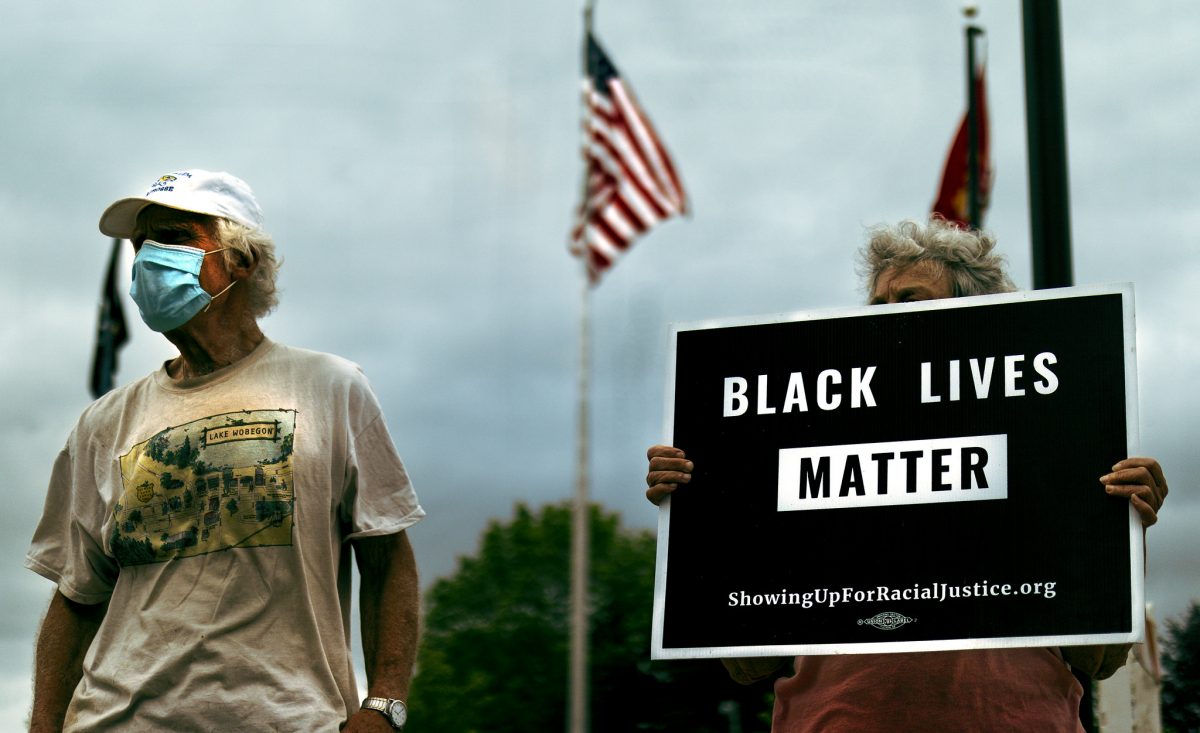“I want to see all of them get punished to the full extent for what they did to my brother,” Terrence Floyd said in an interview Sunday with ABC-TV. “Because when I saw the videos, not only was the dude on his neck … not only that, you got the other three officers behind the camera, behind the car on him. So he can’t move.”
In the interview, Terrence Floyd implored those enraged by his brother’s death to express themselves peacefully. He reiterated the same sentiment when he visited the site of his brother’s death in Minneapolis on Monday. “Let’s do this another way,” Floyd said after mentioning how after every police shooting, people take to the streets and riot, only to do the same thing again and gain. He encouraged those gathered to vote.
“Don’t tear up your town,” he said. “All of this is not necessary, because if his own family and blood is not doing it, then why are you? … Because when you’re finished and turn around and want to go buy something, you done tore it up. So now you messed up your own living arrangements. So just relax. Justice will be served.”

Twin Cities reel from storm of protest and violence
The pain on the faces of young people in Minneapolis as they shout chants like, “No justice, no peace; prosecute the police” is still palpable days after the initial protest of the Memorial Day police killing of George Floyd, live on social media.
The local demand for justice has been joined by over 30 U.S. cities and several countries, where protests have been held in solidarity with the Twin Citians. There is no indication that the protests will subside any time soon.
In the Twin Cities, it is not just residents that are registering their disgust with the police killing of Floyd, but two local educational institutions have announced intentions to cut ties with the embattled department.
In an unprecedented move, University of Minnesota President Joan Gabel said the school would sever some security arrangements with the department. “The University will no longer contract with the Minneapolis Police Department for added enforcement at large events such as football games and concerts,” Gabel said.
“We cannot align itself with MPD and claim to fight institutional racism,” said Minneapolis School Board Josh Polly who drafted a resolution asking the board to “terminate its contract” with the Minneapolis Police Department. “We cannot partner with organizations that do not see the humanity in our students. We cannot be neutral in situations of injustice.” The board has scheduled a special session June 2 to vote on the resolution.

Though it is apparent to many that justice would mean that the four police officers responsible for the death of Floyd should be punished, Hennepin County Prosecutor Mike Freeman has charged only one officer, Derek Chauvin, with third-degree murder.
While State Attorney General Keith Ellison has been appointed by Minnesota Gov. Tim Waltz as lead prosecutor, charges have still not been brought against the other officers involved in Floyd’s death.
Legal experts have also taken issue with the third-degree murder charge. “It is inconceivable that experienced, professional Hennepin County prosecutors did not recognize the potential flaws in the third-degree murder charge,” stated Minnesota ACLU and Minneapolis Legal Rights Center recently in a press release calling for an immediate amendment of charges in the Derek Chauvin criminal complaint.
“Third-degree murder applies only when the acts of the defendant were committed without regard to their effect on any particular person, and not when the actions were directed to a specific person,” stated the release. “Minnesota courts have repeatedly ruled that to support a charge of third-degree murder, the offender’s actions need to be eminently dangerous to more than one person.
“Officer Chauvin’s actions were directed solely towards George Floyd and were not ’eminently dangerous’ to anyone other than George Floyd, although Chauvin and the other officers may have been aware that their actions would ultimately spark the public outrage that has ravaged the Twin Cities ever since. The charge for third-degree murder therefore potentially will not stick.”
Though most of the protests have been overwhelmingly peaceful, with large gatherings throughout the country, the mainstream press has focused primarily on the fires, window breaking, looting and rock-throwing. Surprisingly, police were filmed in several cities wading into non-violent, peaceful protesters, beating and arresting them.
In other incidents, police were caught on film provoking protesters and inciting them. A Minneapolis squad car was caught driving through peaceful protesters in downtown Minneapolis spraying them from his car from a large container of mace. Similar aggression surfaced in New York where videos showed the police driving right into a group of protesters.
The nation awoke on June 1 to frightful pictures of a tanker barreling down on protesters who were marching on Interstate 35W in Minneapolis on the previous day. Luckily, none of the protesters were hurt, only the driver who got roughed up by protesters once they caught up with him. He was first sent to the hospital then released and charged with assault.
Police fired rubber bullets and maced the crowd to get them away from the driver, chasing them off the highway while rounding up and arresting 150 protesters.
There have also been instances in cities across the country of police kneeling with protesters and showing glimmers of solidarity.
Protests have gone on for days now, as they continue to demand that “ALL 4 COPS BE JAILED” which was the caption on the Facebook event post calling for Monday’s rally at the Minnesota State Capitol.
Not only is the pain still apparent, but anger, like the buildings left in ruins in South Minneapolis, is still smoldering among young and old alike.

Outside agitators or the enemy within?
Apparently confused about the rioting and its source, state and city officials stated in a press conference on May 30 that the protesters arrested were from out of town, raising the specter of “outside agitators.” But that assertion—which they later admitted was incorrect—was later contradicted by the facts. A Star Tribune investigation uncovered that just the opposite was true: the overwhelming majority of those arrested were locales.
“It’s the same term used when King and his people were protesting down South. [The term “outside agitator”] was also used in the Kerner Commission report. But it takes away from the agency of the people. It’s like saying they don’t have sense enough to fight back against injustice. Montgomery didn’t need no outside agitator; Detroit didn’t need an outside agitator and Minneapolis sure doesn’t need one,” said University of Minnesota professor of African and African American studies Dr. Rose Brewer.
However, the burning of both U.S. Post Office buildings located near Lake Street and the burning of a beloved local library raised suspicions. The MSR interviewed dozens of youth in the area and they agreed that no one in the community would have burned down the library or post office, which leads to speculation about White Supremacists or anarchists infiltrating the protests.
Although the numbers of outside agitators may have been over-exaggerated initially, Public Safety Commissioner John Harrington confirmed on Sunday night that state intel shows evidence of a White Supremacist invasion and also said they found incendiaries and flammable materials stashed near shopping centers and neighborhoods in Minneapolis.

Gov. Tim Walz has responded to the continued unrest by sending out the National Guard and continuing the now 10 pm curfew for the Twin Cities and a few surrounding suburbs until Wednesday.
Minneapolis resembles a war zone, as burnt-out buildings and businesses number in the dozens along the Lake Street business corridor in the heart of South Minneapolis. Businesses have burned in the Twin City of St. Paul as well, particularly in the Midway area. The majority of the businesses were owned by Latinx, Blacks and other People of Color.
The business owners led by the Lake Street Council have promised to rebuild. The Council has raised over two million dollars to date. “We are overcome with gratitude for the outpouring of support for our Minneapolis businesses,” wrote the Council in a message thanking donors.
“They can rebuild those buildings; George Floyd ain’t coming back,” said a young protester at a May 29 rally in downtown Minneapolis. His words reiterated a sign painted on the wall of one of the burnt-out businesses.
North Minneapolis was also hit. A Black barbershop suffered fire damage as did a fast food take out restaurant. The Cub Foods on Broadway was broken into and looted.
“We are organizing the protection of our community; we will not allow our Black businesses to burn down. These are targeted destruction. Putting ‘Black-owned’ allowed them to be targeted. We don’t know what it is; we just know what it ain’t,” said Elizer Darris, a local community activist and a leader of the recently formed, Twin Cities Defense Team.
The team is organized in partnership with the Minneapolis NAACP to defend the North Side which is predominantly Black. Over the weekend, there were lots of rumors pointing the finger at White Supremacists as perpetrators of the North Side damage.
“There is a consequence later for this destruction with us moving out and others moving in.” Darris continued. “We are not going to allow them to burn up all of the drug stores, gas stations and food stores, all the things that make the place livable. If this continues, the infrastructure will have been gone and therefore make the place unlivable, as unlivable as the police have already made it through the violence against our bodies.”
“Most of the looting and rioting is not being done in George Floyd’s name,” explained one of the Black young men who has been taking leadership in the nightly protesting going on well into the night in direct violation of the curfew.
“There are some very specific things about police murder in the Twin Cities that was the catalyst for these protests and that should continue to be the focus amidst the interference and confusion,” explained Brewer.
The words of MLK defining a riot from his speech, “The Other America,” were read at an impromptu rally on Saturday in South Minneapolis on 31st Street and Nicollet Avenue. King’s words, uttered in 1967, couldn’t ring more true:
“In the final analysis, a riot is the language of the unheard. And what is it that America has failed to hear? It has failed to hear that the plight of the Black poor has worsened over the last few years.
“It has failed to hear that the promises of freedom and justice have not been met. And it has failed to hear that large segments of White society are more concerned about tranquility and the status quo than about justice, equality, and humanity.
“And so in a real sense, our nation’s summers of riots are caused by our nation’s winters of delay. And as long as America postpones justice, we stand in the position of having these recurrences of violence and riots over and over again.”
This article was originally published by the Minnesota Spokesman-Recorder. The feature photo appears courtesy of Laurie Shaull via Flickr
The Minnesota Spokesman-Recorder (MSR) enjoys a living legacy as the oldest Black-owned newspaper in the state of Minnesota and one of the longest-standing, family-owned newspapers in the country.
